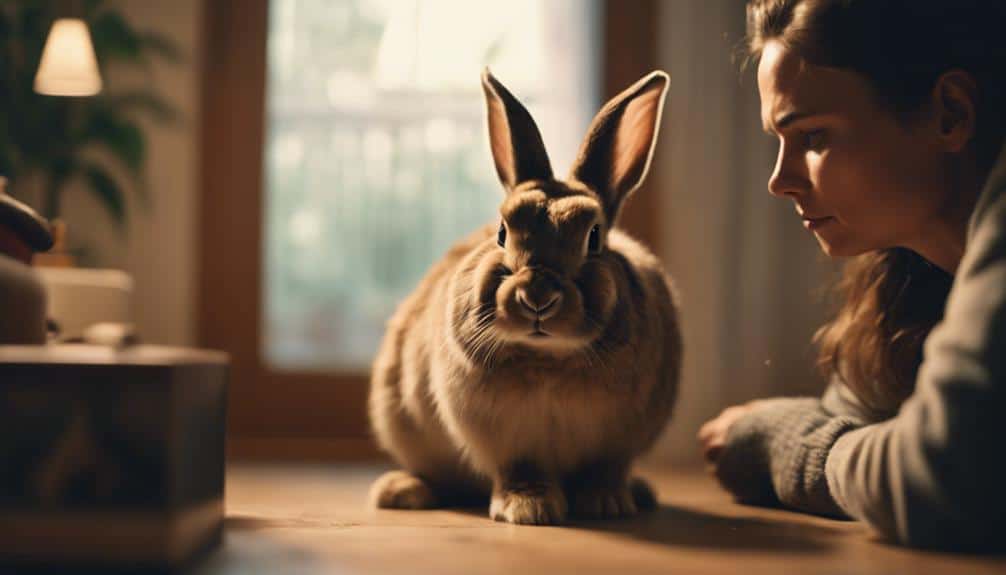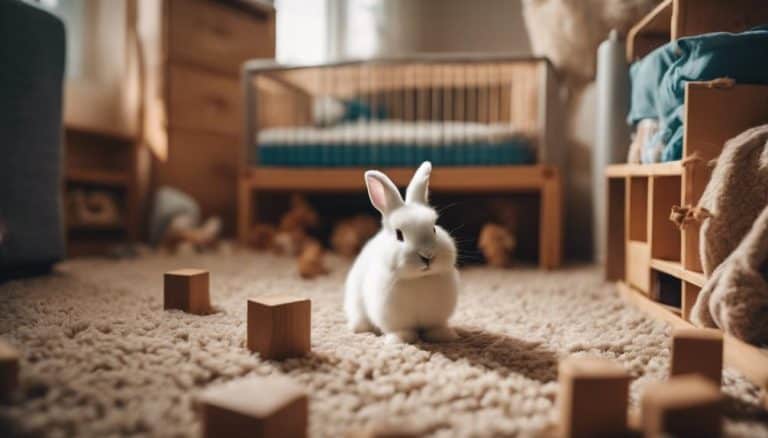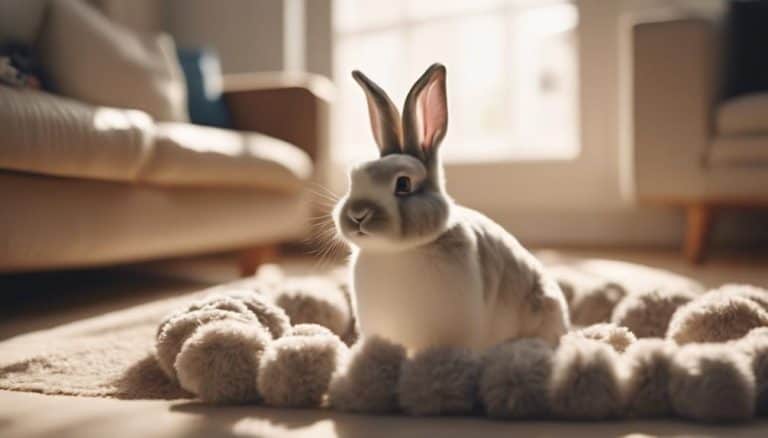Understanding Why Your Pet Rabbit Is Growling and How to Solve It
If your pet rabbit is growling, it might be more than just a quirky behavior. Understanding the reasons behind this growling is essential for ensuring their well-being and your peace of mind. Is your rabbit stressed, anxious, or feeling threatened? Or perhaps there’s an underlying health issue causing discomfort.
By recognizing the context and triggers, you can take steps to address the root causes. Imagine transforming that growl into a content purr through simple, mindful changes. Curious about what specific factors could be at play and how you can effectively address them? Let’s explore further.
Recognizing Rabbit Growling
When you hear your rabbit growling, it’s important to recognize this vocalization as a potential indicator of underlying fear, stress, or discomfort. This growling is often accompanied by other defensive behaviors such as thumping or aggressive body language, including lunging or biting. Understanding and correctly interpreting your rabbit’s behavior is essential for addressing its needs and ensuring its well-being.
To accurately recognize growling, observe the context in which it occurs. Is it during handling, when approached by other animals, or in specific environments? Identifying these situational triggers can provide valuable clues.
Approach your rabbit calmly to avoid exacerbating its stress or fear. Carefully assess the environment for any potential stressors, such as loud noises, unfamiliar scents, or changes in routine.
It’s imperative to take into account the overall behavior of your rabbit. Consistent growling may indicate chronic discomfort or anxiety, requiring a deeper investigation into their living conditions and daily interactions. Consulting with a rabbit-savvy veterinarian or a behaviorist can offer professional insights and tailored strategies to mitigate these issues effectively.
Recognizing and addressing growling behavior is crucial for fostering a harmonious and stress-free environment for your rabbit.
Common Causes of Growling
When you notice your rabbit growling, consider that territorial behavior might be a primary cause, especially in confined spaces.
Health issues such as pain or hormonal changes can also manifest as growling, signaling the need for a veterinary assessment.
Territorial Behavior Triggers
Understanding the common causes of growling in rabbits is crucial for diagnosing and addressing territorial behavior efficiently. When rabbits exhibit territorial behavior, it’s often because they feel their space is threatened. This growling is a clear indication of their attempt to establish dominance. If your rabbit’s environment changes or new animals are introduced, your rabbit may growl to signal their discomfort and assert control over their territory. These reactions are typically rooted in feeling anxious or scared.
Diagnosing territorial growling involves observing your rabbit’s interactions within their environment. Look for patterns, such as growling when you reach into their cage or when other pets approach. These behaviors suggest that your rabbit perceives these actions as a direct threat to their space.
To alleviate this behavior, make sure your rabbit has a secure, designated area where they feel safe. Introducing changes gradually and providing hiding spots can greatly reduce their anxiety. Always approach their territory calmly and avoid abrupt movements that may be interpreted as threats.
Understanding and respecting your rabbit’s need for space will help mitigate their growling and foster a more harmonious environment.
Health Issues Warning
Growling in rabbits can often indicate underlying health issues such as dental problems, gastrointestinal disturbances, or urinary tract infections. When your rabbit growls, it’s important to bear in mind that it might be reacting to fear or pain. Aggression can be a defensive response due to discomfort, making it essential to check for signs of health issues. Regular vet visits are essential for diagnosing and treating these problems early.
| Health Issue | Symptoms | Diagnostic Approach |
|---|---|---|
| Dental Problems | Drooling, decreased appetite, grinding | Oral exam, X-rays |
| Gastrointestinal Disturbances | Lethargy, bloating, reduced fecal output | Palpation, imaging, blood work |
| Urinary Tract Infections | Straining to urinate, blood in urine | Urinalysis, ultrasound |
If your rabbit exhibits any of these symptoms, don’t delay. A vet can perform a thorough examination to pinpoint the exact cause. Dental problems can often be treated with corrective surgery or dietary changes, while gastrointestinal issues may require medication and dietary adjustments. Urinary tract infections typically need antibiotics and increased hydration.
Understanding these potential health issues will empower you to safeguard your rabbit’s well-being. Stay proactive in monitoring their behavior, and always consult a vet to address any signs of fear or pain effectively. This approach will help maintain your rabbit’s health and happiness.
Fear and Past Experiences
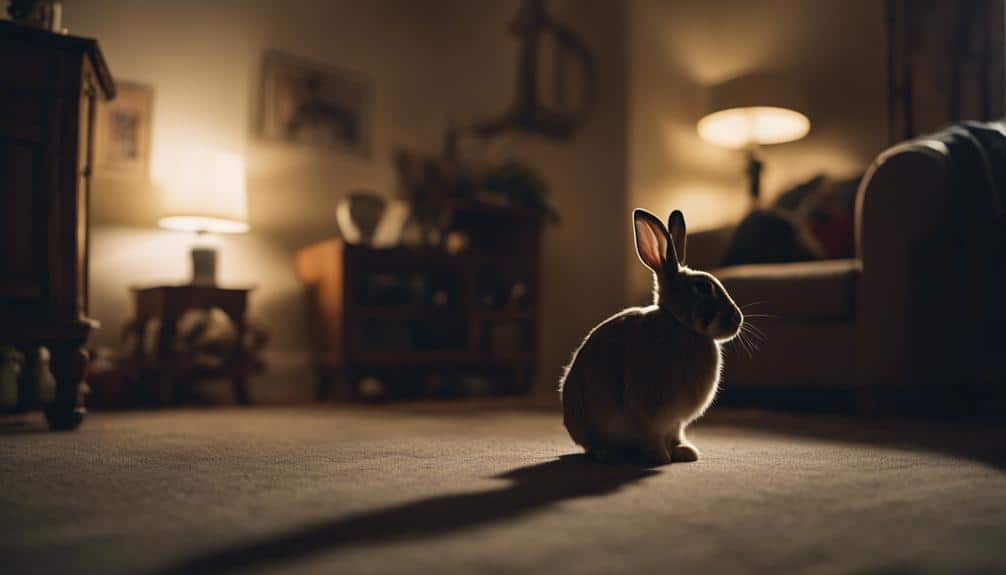
Often, rabbits growl out of fear stemming from previous negative experiences or mishandling. When a rabbit encounters a situation that reminds them of past trauma, they may exhibit growling behavior as a defensive response. Understanding the root of this fear is vital for creating a safe environment where your rabbit feels secure.
To address such fear-based growling, consider the following steps:
- Identify Traumatic Triggers: Observe your rabbit’s behavior closely to pinpoint actions or objects that cause distress.
- Create a Safe Environment: Make sure your rabbit’s living space is calm, secure, and free from potential stressors.
- Gentle Handling: Always handle your rabbit with care to avoid reinforcing their fear and anxiety.
- Positive Reinforcement: Use treats and gentle encouragement to build trust and reduce fear-based reactions.
Addressing your rabbit’s past experiences is essential to mitigate these defensive responses. By recognizing and eliminating traumatic triggers, you can help your rabbit feel more at ease.
Consistent, gentle handling reassures your rabbit that they’re in a safe environment, reducing their need to growl out of fear. Remember, patience and understanding are key to helping your rabbit overcome their past and thrive in a secure, loving home.
Food Insecurity Issues
Food insecurity in rabbits can manifest as aggressive growling behavior, indicating their anxiety over limited resources. When your rabbit feels uncertain about its food supply, it may exhibit growling as a defensive mechanism. This behavior often stems from food insecurity, where the rabbit perceives a threat to its access to nourishment.
To mitigate this issue, establish a consistent feeding routine. A predictable schedule can alleviate anxiety, guaranteeing your rabbit that food will always be available. Additionally, providing a variety of food options, including ample hay and fresh vegetables, can reduce the perceived competition for food.
If multiple rabbits share the same space, competition for food can exacerbate aggressive tendencies. To address this, make sure each rabbit has its own feeding station, minimizing the potential for conflict.
Observe your rabbits during feeding times to identify any signs of aggression or growling behavior, which can indicate ongoing food insecurity.
Hormonal Changes
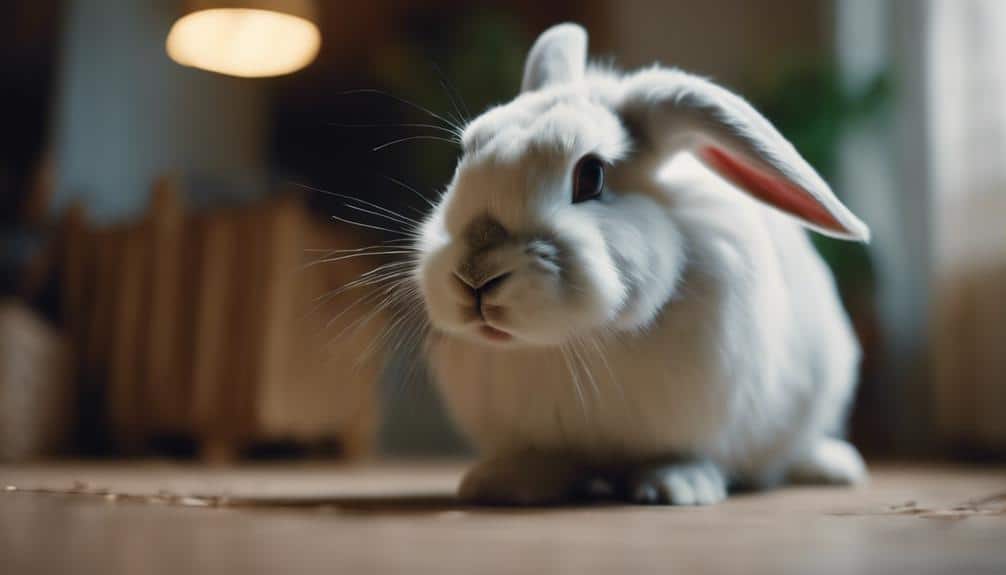
Hormonal changes during puberty or the mating season can greatly affect your rabbit’s behavior, leading to territorial growling. Elevated testosterone in males and estrogen in females often trigger aggressive and dominant behaviors.
Spaying or neutering is an effective intervention to mitigate these hormonal triggers, and consultation with your veterinarian is recommended for best timing and procedures.
Territorial Behavior
Territorial growling in rabbits frequently stems from hormonal changes, particularly during mating season or puberty. These hormonal shifts can lead to increased territorial behavior as your rabbit attempts to establish dominance. This is especially common in unspayed or unneutered rabbits, where the drive to mark territory and establish mating rights is strong.
To manage and mitigate territorial aggression, consider these actions:
- Spaying or neutering: This can greatly reduce hormonal aggression and decrease territorial behaviors.
- Providing a spacious environment: Ensuring your rabbit has ample space can alleviate stress and minimize growling.
- Creating a secure habitat: A secure environment helps your rabbit feel safe and less territorial.
- Behavioral training: Positive reinforcement techniques can encourage non-aggressive behavior.
Understanding your rabbit’s need for territory and dominance is essential. Spaying and neutering are effective clinical interventions to control hormonal surges, which often drive these aggressive behaviors. By addressing these hormonal changes and providing a stable, secure environment, you can help your rabbit feel more at ease and reduce instances of growling. Remember, diagnosing the root cause of territorial behavior is the first step toward a harmonious relationship with your pet rabbit.
Mating Season
Recognizing the profound influence of hormonal changes during mating season is key to understanding why your rabbit might growl and exhibit aggressive behaviors. During this period, unspayed or unneutered rabbits experience notable hormonal shifts that drive them to become more territorial and assertive. These hormonal changes can lead to increased growling as your rabbit attempts to establish dominance within its environment.
Mating season naturally heightens your rabbit’s instinctual behaviors. You may notice your rabbit becoming more vocal and displaying aggressive behavior, such as lunging or biting, as they’re propelled by their innate desire to mate. This territoriality is a direct consequence of the hormonal changes they undergo, making them more defensive and prone to aggressive displays.
To mitigate these behaviors, consider spaying or neutering your rabbit. This procedure effectively reduces hormonal aggression by eliminating the reproductive drive, thereby curbing the need for your rabbit to establish dominance and territoriality.
Understanding and addressing the impact of mating season on your rabbit’s behavior through these measures can significantly enhance both your rabbit’s well-being and your overall experience as a pet owner.
Space and Environment
Creating an essential living space and a peaceful environment is key for minimizing growling behavior in pet rabbits. To address this issue effectively, start by ensuring that your rabbit has ample space to move around. Confinement can lead to stress and defensive growling.
Provide an environment enriched with multiple hiding spots, each with at least two exits. This setup helps your rabbit feel secure and less prone to aggression.
Rabbits are territorial animals; establishing a settled territory with consistent access to their favorite hiding places can greatly reduce stress-induced growling.
Ensuring a peaceful environment is also vital. Loud noises and sudden movements can trigger defensive behaviors, so aim to keep the surroundings calm and predictable.
In addition, consider the benefits of a neutered companion. A neutered rabbit companion can provide social interaction, reducing loneliness and associated stress, which in turn can minimize growling.
Here’s a quick checklist to optimize your rabbit’s environment:
- Provide ample space for movement.
- Create multiple hiding spots with two exits.
- Maintain a peaceful and quiet environment.
- Introduce a neutered companion for social enrichment.
Building Trust With Your Rabbit
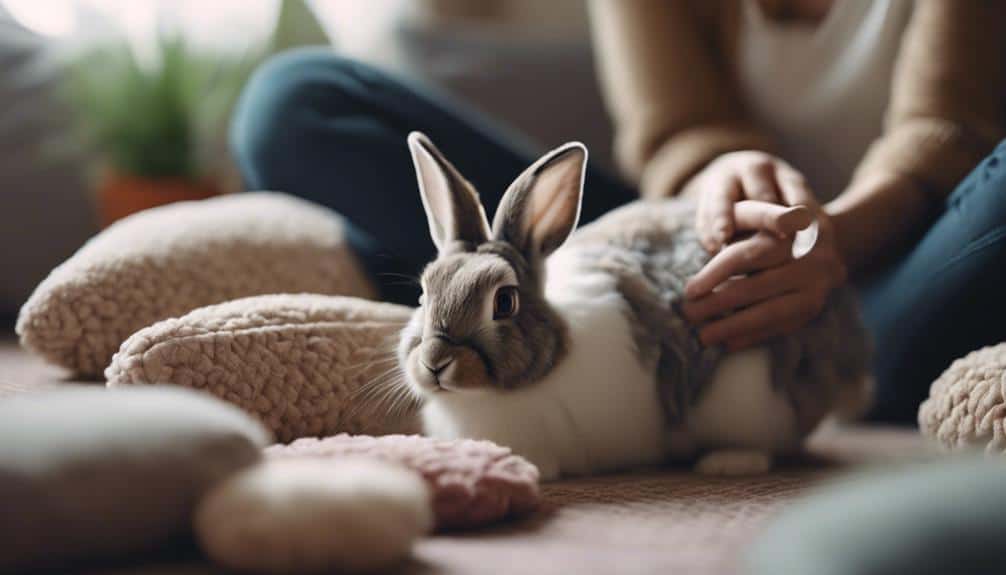
To build trust with your rabbit, allow them to initiate contact and gradually acclimate to your presence. This approach respects their personal space and reduces stress. Observe your rabbit’s body language; signs of discomfort include thumping, hiding, or flattening their ears. Create an environment that includes hiding spots where your rabbit can retreat when they feel threatened or overwhelmed.
Patience is vital. Avoid sudden movements and loud noises that could startle your rabbit. Consistent behavior is essential; interact with your rabbit at regular intervals and maintain a calm demeanor. Over time, your rabbit will associate your presence with safety and predictability.
Here’s a quick guide to understanding and applying these principles:
| Principle | Action | Benefit |
|---|---|---|
| Building Trust | Let the rabbit initiate contact | Reduces stress, fosters curiosity |
| Personal Space | Avoid encroaching on their territory | Creates a sense of security |
| Body Language | Watch for signs like thumping or hiding | Helps you gauge their comfort level |
| Hiding Spots | Provide shelters and tunnels | Offers a safe retreat, reducing anxiety |
| Patience | Move slowly, speak softly | Prevents startling, builds gradual trust |
Positive Reinforcement Techniques
Once you’ve established trust with your rabbit, employing positive reinforcement techniques can effectively encourage desired behaviors and mitigate negative ones, such as growling. Positive reinforcement involves rewarding desired behaviors with treats or praise, which helps in trust building and creating a positive association with non-aggressive behavior.
To implement positive reinforcement effectively, consider the following:
- Reward Calm Behavior: Give a treat when your rabbit exhibits calm, non-aggressive behavior.
- Immediate Response: Reward immediately after the desired behavior to establish a clear connection.
- Consistent Reinforcement: Consistency is essential; make sure to reward the behavior every time it occurs.
- Use Praise: Verbal praise can be as effective as treats and helps in reinforcing the behavior without overfeeding.
Consistency and Patience
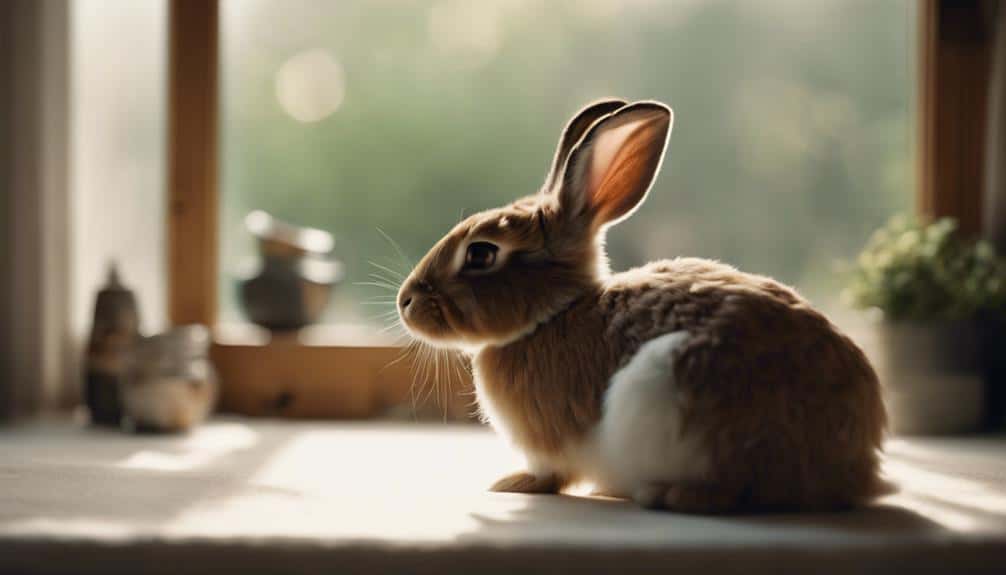
Maintaining a consistent approach in your interactions with your rabbit is vital for diminishing growling behavior and fostering a sense of security. Consistency in handling creates a predictable environment, which is essential for building trust. When your rabbit knows what to expect, it can start to feel more at ease, reducing the likelihood of stress-induced growling.
Patience is another cornerstone in this process. Behavioral changes in rabbits don’t happen overnight. You need to allow your rabbit time to acclimate to new experiences. Gradually introducing positive experiences can help your rabbit associate human interaction with safety and comfort. For example, gentle petting sessions or offering treats can reinforce that being around you is a pleasant experience.
Establishing a routine is also advantageous. Rabbits thrive in environments where they can predict daily events. Feeding, playtime, and cleaning should occur at the same times each day. This routine helps reduce anxiety, leading to less growling.
Lastly, make sure your rabbit has a safe space to retreat to when feeling overwhelmed. A calm, quiet area allows your rabbit to decompress, contributing to overall emotional stability. Through consistency, patience, and creating positive interactions, you can foster a trusting and harmonious relationship with your rabbit.
Conclusion
By understanding the root causes of your rabbit’s growling and addressing them through a diagnostic approach, you can foster a more harmonious relationship.
Focus on creating a secure environment, ensuring food security, and considering hormonal influences.
Build trust through consistent routines and positive reinforcement.
Patience and a proactive strategy will help alleviate your rabbit’s stress and discomfort, ultimately reducing growling behavior.
Your dedication to their well-being is vital for a happy, healthy pet.

